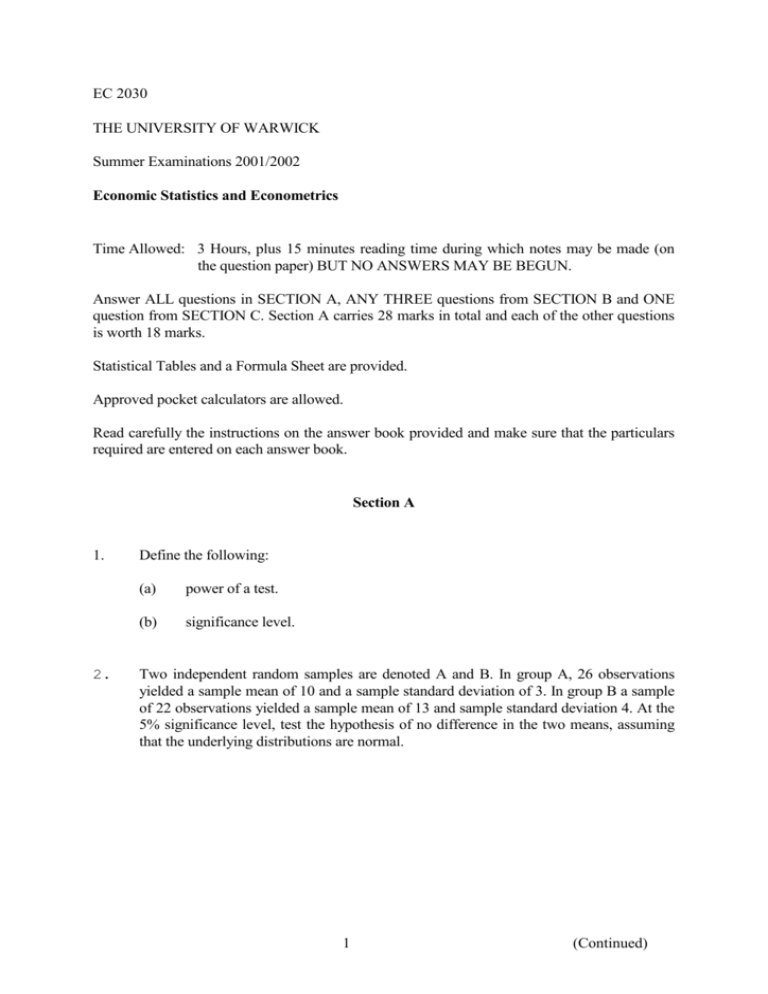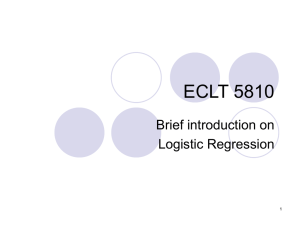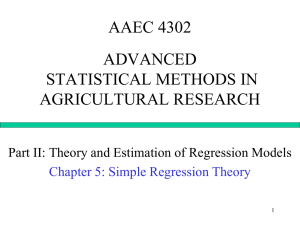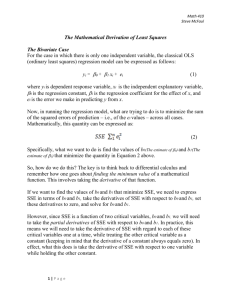ec 2030 - University of Warwick
advertisement

EC 2030 THE UNIVERSITY OF WARWICK Summer Examinations 2001/2002 Economic Statistics and Econometrics Time Allowed: 3 Hours, plus 15 minutes reading time during which notes may be made (on the question paper) BUT NO ANSWERS MAY BE BEGUN. Answer ALL questions in SECTION A, ANY THREE questions from SECTION B and ONE question from SECTION C. Section A carries 28 marks in total and each of the other questions is worth 18 marks. Statistical Tables and a Formula Sheet are provided. Approved pocket calculators are allowed. Read carefully the instructions on the answer book provided and make sure that the particulars required are entered on each answer book. Section A 1. 2. Define the following: (a) power of a test. (b) significance level. Two independent random samples are denoted A and B. In group A, 26 observations yielded a sample mean of 10 and a sample standard deviation of 3. In group B a sample of 22 observations yielded a sample mean of 13 and sample standard deviation 4. At the 5% significance level, test the hypothesis of no difference in the two means, assuming that the underlying distributions are normal. 1 (Continued) EC 2030 3. Calculate the approximate power of the t-test calculated in question 2, given that A-B=-3.0. What is the Type I error for this test? 4. For the following regression model, estimated using annual data from 1940 to 1999, Y t 0.021 0.920 X t e t (0.038) (standard error in parentheses) 5. (a) Test at the 5% significance level that the slope coefficient is unity. (b) What is the forecast for year 2000, given that X2000 = 4.1? (c) A dummy variable Dt is added to the equation, taking value unity in 2000 and zero otherwise. The regression is re-estimated over the period 1940 to 2000 using the data point X2000 = 4.1, but data for Y2000 is unavailable so the researcher simply inputs a zero value for Y2000. Interpret the coefficient on Dt. Consider the following regression model: Yt 1 2 X 1t 3 X 2 t t rearranging equation (1) we get: (1) Yt X 2 t 1 2 ( X 1t X 2 t ) 3 X 2 t t (2) (a) Express each of the parameters, 1 , 2 , 3 as a function of 1 , 2 , 3 (b) Hence or otherwise show how one can test the hypothesis 2 3 1 using only equation 2. 2 (Continued) EC 2030 6. Estimating a model by OLS for imports (m) against relative prices (domestic prices/foreign prices) (p/p*), and real GDP (y) for the UK using quarterly data over the period 1978:1 to 1997:4 yielded the results: ln( mt ) 0.045 0.5 ln( p t / p t* ) 0.6 ln( y t ) e t (0.042) (0.125) (0.201) (1) , ln = natural log . R2 0.962 , SSE 0147 (standard errors in parentheses) (a) (b) 7. Calculate the power of the test (at the 5% significance level) that the coefficient on the variable ln(y) is zero, given that the true coefficient is 0.3. 1 t 1994 : 1 1997 : 4 The variable ln( p t / p*t ) * D t , where D t , is added to otherwise 0 equation (1), which is then re-estimated. Interpret the coefficients of this new equation. Explain what the implications on the properties of the OLS estimators are for each of the following: (a) Omitted relevant variables. (b) An outlier in one of the explanatory variables. 3 (Continued) EC 2030 Section B 8. (a) The West Anglia Great Northern Railway (WAGN) and Chiltern Railways (Chiltern) have both attempted to prevent recent rail maintenance work leading to an increase in rail journey time. A random sample of 100 rail journeys were taken for each company. For WAGN, the average journey time rose by 3 minutes, with a standard deviation of 15.5, whereas for Chiltern the average journey time rose by 1.3 minutes, with a standard deviation of 16.1. At the 5% significance level: (b) (i) Separately test whether WAGN and Chiltern have been successful in preventing increased journey times. Write a sentence summarising the findings of these tests. (ii) Test whether WAGN has been more successful than Chiltern in preventing an increase in journey time. In 1994 two American economists claimed that male catering staff earned more than females performing the same job. A random sample of 50 female catering staff was found to earn an average of $16,000, with a standard deviation of $2,600, while a sample of 40 male catering staff was found to earn an average of $17,300, with a standard deviation of $3,000. (i) What is the power of a test at the 5% level of the American economists’ claim, given that male catering staff are truly paid £100 more than female catering staff? (ii) Diagramatically represent the power and significance level of the test conducted in (b) (i). (ii) At the 10% level, is there a significant difference between the two groups in the variance of earnings? 4 (Continued) EC 2030 9. The following estimated equation was obtained by Ordinary Least Squares using quarterly data for the period 1963:3-1992:4 inclusive: y t 0.010 0.209 w t 0189 . x t 0187 . zt et (0.072) (0.058) (0.088) Regression Sum of Squares (SSR) = 0.0035, Error Sum of Squares (SSE) = 0.0157 (standard errors are given in parentheses) (a) Test whether each of the coefficients are significantly different from zero at both the 5% and 1% significance level. (b) Calculate (i) the coefficient of determination (R2) and (ii) the standard error ( ) of the regression. (c) Test the significance of the regression. (d) Test the hypothesis that the coefficient on wt is equal and opposite to that on zt, given that the covariance between the coefficients is -0.0015. Why might the researcher want to impose this restriction? (e) Given that z t w 3t , test the hypothesis that the marginal response of yt to wt is zero at w t 1 , given that the covariance between the coefficients is-0.0015. (f) Without assuming any particular relationship between the variables, calculate the SSE of the following restricted version of the model: y t 0 1w t 2 x t e t . 5 (Continued) EC 2030 10. A researcher collected seasonally adjusted quarterly data for the UK over the period 1979:1 to 2001:4 on the three variables Lm = Natural log of real broad money (M3) Ly = Natural log of real Gross Domestic Product (GDP) r = 3 month Treasury bill rate Table 1 contains the results, as reported by PcGive, for a money demand equation for the UK using quarterly data over the period 1980:1-1999:4. (i) Provide answers for the 6 spaces, marked ??(x) in Table 1. (ii) Using the results of Table 1 and Figure 1, explain how you would proceed from this initial general regression model to a more appropriate and parsimonious model. (iii) Explain what other tests you might think of using to test the validity of your preferred model. TABLE 1 EQ(1) Modelling Lm by OLS Variable Coefficient Constant 1.9304 Ly 0.1642 Ly_1 0.2287 Ly_2 0.2056 Ly_3 -0.1056 R -0.0131 r_1 -0.0123 r_2 0.0098 r_3 -0.003 Lm_1 0.4532 Lm_2 -0.1921 Lm_3 0.0765 sigma ??(c) R^2 ??(d) log-likelihood -112.858 no. of observations 80 mean(y) 4.4986 AR 1- 4: ARCH 4: Normality: Hetero Test: RESET: t-value t-prob 1.961 0.050 1.462 ??(a) 1.872 0.061 1.553 0.120 0.337 ??(b) -1.351 0.177 -1.352 0.176 0.961 0.337 -0.303 0.762 2.997 0.003 -1.296 0.195 0.617 0.537 RSS 0.02886 F(11,68) = ??(e) [0.000]** DW 2.16 no. of parameters 12 var(y) 0.00201 F(4,64) = 1.0382[0.394] F(4,60) = 2.283[0.071] 2 Chi (2)= 15.197[??(f)]*** F(22,45) = 1.2019[0.294] F(1,67) = 0.03373[0.855] (Question 10 continued overleaf) 6 (Continued) EC 2030 (Question 10 continued) Figure 1: 4 Lm ´ Fitted r:Lm (scaled) 4.6 2 4.5 0 4.4 -2 4.35 4.40 Density r:Lm 4.45 4.50 4.55 4.60 1.0 N(0,1) ACF-r:Lm 0.5 0.4 0.0 0.2 -0.5 -2 0 2 4 7 0 5 10 (Continued) EC 2030 11. A model is specified as y t 1 x1,t 2 x1,t 1 3 x 2,t 1 4 x 2,t 2 5 y t 2 t (1) Estimating this model using quarterly data over the period 1983:1-2000:4 resulted in y t 0.424 0.624 x1,t 0.361x1,t 1 0.618 x 2,t 1 0.381x 2,t 2 (0.201) (0.168) 0.576 y t 2 et (0.152) (0.202) (0.189) (0.229) R 0.705, Error sum of squares (SSE) 39.172 (Standard errors in parentheses) 2 (a) Calculate the response in y to a unit increase in x1 and x2, (i) contemporaneously, (ii) after 1 period, (iii) after 2 periods, (iv) after 3 periods, (v) in the long run. (b) Test the hypothesis that the long run response of y to x1 is –0.5, given that cov( b1 , b 2 ) 0.020 , cov( b1 , b5 ) 0.01 and cov( b 2 , b5 ) 0.009 . (c) Write out the restricted model that you would estimate in PcGIVE if you wanted to impose the two hypotheses that the long-run coefficient on x1 is –1 and the long-run coefficient on x2 is zero. How many parameters would you estimate in the restricted model? (d) The Durbin-Watson statistic for the estimated equation (1) is 1.316. Based on this information what do you conclude about the model (1)? (e) Describe the regressions you would run in order to construct the AR1-4 test reported by PcGIVE. The p-value on the resultant F-statistic was 0.02. In light of this information and that in (d) how would you suggest modifying equation (1)? 8 (Continued) EC 2030 12. An equation to determine happiness from a random sample of 600 employed individuals is estimated based on the following model ln( Happy i ) 1 ln( Income i ) 2 Female i 3 Married i 4 SOCIi (1) 5SOCIIi 6SOCIII i 7 SOCIVi 8 Educ i 9 Age i where, Happy = Happiness score (out of 100) Income=Annual income (£000s) Educ = Number of years in education Age = Age 1 fe male 1 Married , Married i , Female i 0 male 0 Otherwise 1 SOCI i 0 1 Managerial 1 Skilled 1 , SOCIII i , SOCIVi SOCII i 0 Otherwise 0 Otherwise 0 1 Unskilled . SOCVi 0 Otherwise Pr ofessional , Otherwise Semi - Skilled , Otherwise Estimating equation (1) by OLS resulted in an error sum of squares (SSE) of 6.37 and a regression sum of squares (SSR) of 2.72. (a) Excluding the variables SOCI, SOCII, SOCIII and SOCIV from equation (1) and estimating the resultant equation by OLS, yielded an SSR of 2.48. Test the joint significance of these variables. (b) The Standard Industrial Classifications (SIC) defines nine single digit industry types. Explain how you would include variable(s) to control for the different industry types in equation (1). Estimating equation (1) by OLS with the inclusion of the industry variable(s) the SSE fell to 6.08. Test the significance of this (these) variable(s). (c) Equation (1) is re-estimated separately for the 278 males and the 322 females in our sample. Estimating these two models yielded SSEs of 3.13 and 3.02, respectively. Comparing this model with equation (1), carefully explain what null hypothesis you are testing, and test this hypothesis. (d) Adding three interacted dummy variables to equation (1), (Female)´(Educ), (Female)´(Age) and (Female)´ln(Income) the SSE fell to 6.18. Test the joint significance of these additional variables. (e) Compare the model estimated in (d) with the two models estimated in (c). Write out the restrictions you must impose on the model described in (c) to produce the model in (d) and test the restrictions. 9 (Continued) EC 2030 13. Consider the following model: y t 1 ln( x 1t ) 2 x 2 t u t ,t 1, , n (1) (a) Interpret the coefficients in equation (1) (b) Interpret the coefficient on the variable ln(x1t) in (1) if this variable is multiplied by 100. Discuss the consequences of estimating equation (1) by OLS, in terms of the OLS estimators, b1 and b2, and the standard errors of these estimators, in each of the following circumstances: (c) ut is serially correlated, when x2t = yt-1. (d) x 2t = [ln(x 1t )]2 (e) x2t is unobservable and is therefore excluded from the estimated equation. (f) t 1, n 1 1 . How could you improve upon OLS in this case? V(u t ) = 2 t n 1 1 n (g) 0 x 2t = 1 t 1, 16,18, n . t 17 Section C 14. Blundell et al (2000) show that average earnings for both males and females who went to university are markedly greater than those individuals who did not attend university. Discuss this statement in the light of the statistical evidence on the returns to a university degree. 15 Econometric models enable us to test competing economic theories against actual data. Economic models which prove to be data inconsistent can then be discarded and more appropriate models developed. Discuss. 10 (End)









